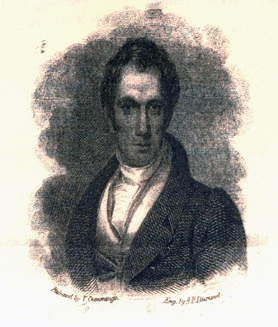In the last year or so, because of the interest in saving St. Saviour’s Church in Maspeth, we have been asked by different people to find information to support the establishment of the church as a city landmark. Contributing to the historical significance of a site or structure are people associated with it. One of the founders of the church that we particularly enjoyed researching was Garrit Furman.
Garrit Furman was probably born near an old farming village called Dry Harbor, which was a forerunner of today’s Glendale. The name survives in the street name, Dry Harbor Road. The new Atlas Shopping Center now occupies much of the site of the old village.
In researching Furman we came across a very old book in the Long Island Division (of the Queens Public Library) called Long Island Miscellanies published in the 1840s. The author of the book is listed as “Rusticius,” which is a pen name Furman adopted when he started writing articles for the “Long Island Star,” a Brooklyn newspaper that dates from the 1820s. The book is apparently a compilation of many of these pieces. A number of them have to do with his growing up in Queens. Unfortunately, he is a bit short on specific details, but he does say that he went to the White Pot school house, probably in the early 1790s (He was born in 1782), which according to Furman was about halfway between Dry Harbor and the village of White Pot. White Pot is now Forest Hills. He also says that he apprenticed to a local tailor after he left school. Eventually he went to live in Manhattan where he did quite well in business. An 1820 announcement in a Manhattan newspaper announces his appointment to the Board of Directors of the Franklin Bank.
According to Furman, while an apprentice he went with his boss to a community then called English Kills to buy supplies. This was the Maspeth dock on Newtown Creek. He fell in love with the area and in 1815 he purchased what was then known as Mott's Island from the Mott family. Later called Furman’s Island, it was barely separated from the mainland to which it is now attached by landfill. Here he erected a beautiful mansion. Furman claims to have restored the old Indian name “Maspeth” to the area, which he says he saw mentioned in an old deed. Furman, born right at the end of the Revolution, was proud of his patriotism and would not have liked living in a community called English Kills. In some of his newspaper articles he talks about the old timers in the area and their reminiscences about the Revolution and such heroes as Washington and Lafayette.
He loved to spend time at the Maspeth Hotel which was an old fashioned inn near the Town Dock where you could go for a pint of rum and sit by the fire talking to your neighbors. It is hard to believe, knowing what we know of this part of Maspeth today, that Furman actually wrote a book called “The Maspeth Poems.” In it there are a number of nature poems inspired by his living on the island. There is even a poem called “The Maspeth Hotel” which conveys the good times he spent there. All of what Furman loved about the community is long gone and when we think of this area today we think of Newtown Creek and the environmental nightmare it has become.
Unfortunately, I couldn’t find any mention of St. Saviour’s in Furman’s books. The church was only opened a year before Furman died. It is a stone’s throw from where the dock and Maspeth Hotel used to be and not far from the Furman mansion. It would be a terrible shame to see this only survivor from the days when Garrit Furman lived there torn down.
(Garrit Furman, along with James Maurice, John Van Cott and David Jones, founded “The Maspeth Church” in 1846. The congregation originally met in a room in the Maspeth Hotel, which is mentioned in the above article. The Maspeth Church was renamed “St. Saviour’s” in 1847 when it was decided that a church edifice would be built.)



